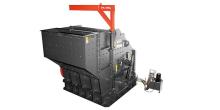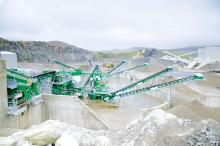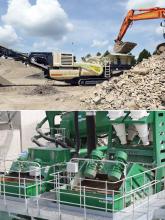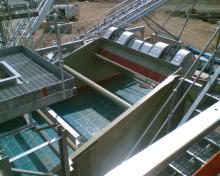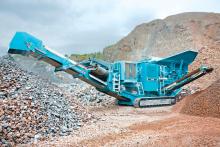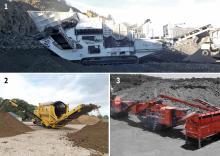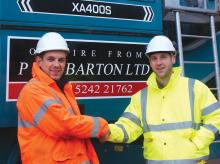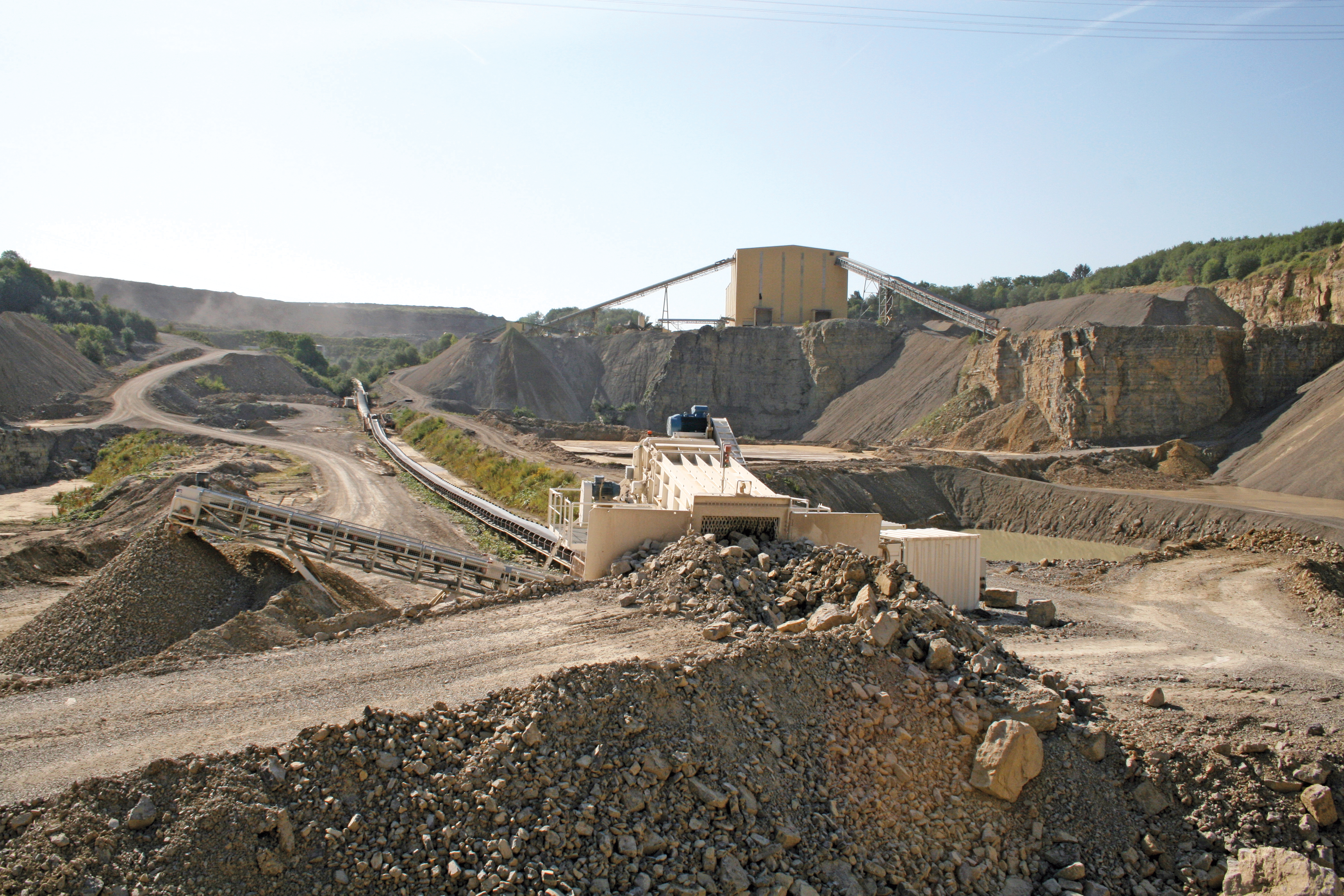
The requirements for building materials, concrete and asphalt have continuously risen in recent years. This has meant that requirements on the gravel, chippings and sand used in their production have also risen.
“Since demand for high grade crushed sand and high quality aggregates is also constantly rising, gravel and aggregate plants have to expand and equip their machine pools in order to meet the European standards and directives that require increased use of high quality aggregates,” says
Many plant operators have taken note of the standards/directives and have renewed or upgraded their crushing and screening equipment, the latest developments offering increased productivity and lower operating costs.
Indeed, BHS-Sonthofen says its RSMX series rotor centrifugal crushers is ideal for processing hard and medium-hard rock to produce aggregate chippings and high-quality aggregates. It uses the rock-on-rock principle for its patented rotor with just two centrifugal chambers and offers machines in four different sizes for throughput rates of up to 400tonnes/hour with maximum input grain sizes of up to about 80mm for hard rock and up to 150mm for soft rock.
Other new introductions are coming from
Claimed by Terex Finlay to be a compact and aggressive tracked primary jaw crusher, the J-1170 is said to have a robust hydrostatically driven Terex jaw chamber which provides high capacity with large reduction ratios. The jaw chamber configuration can be set up specifically for either processing construction demolition debris or quarrying applications.
The J-1170 is built around the Terex 1,100mm x 700mm jaw crusher, and is powered by either a Tier 3/Stage 3A
Sandvik, introducing a number of new mobile and stationary models, says its new generation of Prisec CI5 Series horizontal impact crushers (HSI) combines the ability to configure one base crusher into either a primary or a secondary configuration, thus making it adaptable to ever-changing requirements.
“The new HSI range of crushers from Sandvik Construction have been developed in response to customer demands, building on the rock solid foundation of the primary and secondary series they will replace,” says the company.
The series is spearheaded by the CI511, which has a nominal throughput rate of 200tonnes/hour, and a 1,005mm high, 950mm wide rotor diameter allowing a maximum feed size of 600mm while the company’s all-new patented Sandvik CH550 compact cone crusher is based on the proven Hydrocone design.
Sandvik Construction Mobile Crushers and Screens has also unveiled plans to launch two new mobile additions, including the latest incarnation of its original E7 mobile scalper and a new impactor model.
Meanwhile,
The contract is valid on a worldwide basis, excluding the US, Canada and Mexico, where the agreement is of non-exclusive type.
“With this agreement, we are able to combine Metso’s proven knowledge of impact crushers with the special experience of Magotteaux regarding composite type of blow bars used with impactors,” says Osmo Mäki-Uuro, vice president Crusher Wear Solutions, Mining and Construction, Metso.
“Metso’s sales network can now widen its services offering by bidding our customers with a more efficient and economical Magotteaux solution, used normally at quarry and recycling applications. As a bonus, the working safety will be improved thanks to the longer wear change intervals,” Mäki-Uuro adds.
According to the agreement, Metso’s global sales and service network and its distributors are the sole channels to offer the Magotteaux blow bars and impact plates marketed under Xwin, Recyx and neoX product brands for all Metso crushers (except the US, Canada and Mexico).
Attached around the rotor of the impact crusher, the blow bars are the key parts securing efficient impact crushing. Typically, impactors are used to primary and secondary crushing of medium hard materials such as limestone.
The Baresel company, said to be one of the most successful gravel and limestone manufacturers in south-west Germany, and based near Stuttgart, says it increased its production capacities with the support of
“Since July 2012 the plant has been non-stop in use and completely satisfies the customer’s expectations,” says the company.
“It is the pre-crushing of limestone with a throughput capacity of 900tonnes/hour that is a significant role for the new primary crushing plant.”
The products are used by Baresel for the extraction of aggregates for the ready-mixed concrete and finished part industry as well as high quality chippings for asphalt mixing plants.
“The wide range of products at the Ehningen site comprises shell limestone for all ranges of application in road, landscape and concrete construction.
“It was important to design a variable and mobile platform during the planning phase in order to permit quarrying directly at the working area, today, as well as for the future quarry advance. A high degree of mobility of the plant was a clear specification requirement of this project,” says Hazemag.
“Taking into consideration the above targets and design data the customer decided in favour of the impact roll crusher SB 1518 R. An integrated chain scraper, which autonomously feeds the feed material in the impact range of the crushing roll, serves as conveyor medium. A roller screen, which is integrated in the chain conveyor and screens out the <60mm fraction, considerably reduces the generation of fines while the material passes the crushing gap.”
To easily move the crusher in the quarry area it was fitted with a powerless crawler track. Two belt conveyors serve for discharging the material: one positioned beneath the roller screen, laterally discharges pre-screened material, while the other, beneath the discharge of the chain scraper, serves for passing the pre-crushed rock onto a belt.
In the UK,
The Powerscreen XA400S and Powerscreen 1000
“Specifically developed for larger end users, the Powerscreen 1000 Maxtrak cone crusher can accept an all-in feed, thereby eliminating the need for pre-screening. The feed hopper is equipped with a level probe that maintains choke feeding of the cone crusher, improving cubical shape and increasing fines production for road-base applications,” says Powerscreen.
The new machines are now at work in an
Meanwhile,
A key feature of these new machines is the hoisted articulated crusher jaw. This prevents blocking of coarse material and removes fastening elements for the crusher jaw from the wear area. Kleemann achieves outputs of up to 300tonnes/hour.
“The crusher is directly driven and all the other components are driven electrically. We used to have a hydraulic drive to the crusher but now we have a direct drive,” says Hezinger.
“Screening is one of the most crucial parts of the quarrying process: it is where the raw materials are transformed from the mixed form in which they come out of the ground into graded, market-ready products,” says Russell Lafford, product manager, screens, at
“While the process is fundamentally quite simple, achieving reasonable efficiency from the process requires careful selection and calibration of the equipment.
“All Weir Minerals screens use linear motion to excite the mixture being screened and speed up the process. The big advantages of linear motion screens are that it is easier to control the speed at which materials pass over the screen and that pegging (particles becoming wedged in the holes decreasing efficiency and demanding maintenance intervention) is reduced.
“It is also a simpler arrangement than a circular screen, and this allows units to have a lower total height, often a primary concern where space is at a premium.
“It is also important to ensure that the frequency and amplitude of vibration is correct for the specific mixture being separated by the screen, so the motor or geared exciter used to create the vibration also needs to be carefully specified. Some processes incorporate ten or more different screening stages, each demanding different dimensions, aperture sizes and vibration speeds to suit the specific job.
“Because screening calls for such a wide range of product sizes, as well as offering frequently used units off-the-peg, Weir Minerals also builds custom screens to ensure optimum performance on specific tasks.
“The newest innovation in screening is the development of banana screens, which feature a varying incline which can range from 45º right through to horizontal within a single unit. These high-throughput screens can classify a number of different products, reducing set-up costs and increasing efficiency.”
US company Cemco, which supplies equipment worldwide, says its new Turbo 128 V-Twin VSI Crusher can process materials up to 152.5mm in diameter, and is among the largest models in its line of vertical shaft impact crushers.
“The crusher is ideally-suited for the production of 1½inch [38mm] aggregate rock commonly used in concrete for roadbuilding applications. Additionally, the Turbo 128 is fully customisable to enable production of several types of aggregate materials, opening it up for use in a variety of industries including energy production, mining and recycling,” says the company.
The Turbo 128 weighs approximately 19tonnes and offers production capabilities up to 900tonnes/hour.
“The Turbo 128 V-Twin is offered in a trailer-mounted configuration to enhance portability and convenience. Other options include a water flush system, designed for wet or sticky material, dust control systems, diesel motors and automation software,” says Cemco.
Meanwhile,
The M2500, now installed in 20 countries throughout Europe, Middle East, Africa, Australasia and Latin America, has existing applications across a wide range of materials including sand and gravel, crushed rock, scalpings, construction and demolition waste recycling, silica sands and iron ore processing.
“The new M2500 features include enhancements to the configuration of the integrated ProGrade screen which ensure maximum transfer of energy to the material being processed while isolating the supporting chassis from vibration,” says CDE research and development manager, Kevin Vallelly.
“In addition we have made a number of modifications designed to facilitate improved maintenance access which maximises plant production.”
Additional improvements include a new polyurethane protection system for the ProGrade screen cassettes and enhancements to the integrated AtroFeed system for delivery of the sand fraction to the on board EvoWash whose next generation is also being launched.
The EvoWash compact sand washing system integrating a dewatering screen, sump and hydrocyclone configuration is customised to the specific requirements of the materials washing project on which it is specified.
“2013 represents a significant year for the EvoWash as it is 21 years since the system was first introduced,” says Kevin Vallelly, research and development manager with CDE.
“Our 2013 EvoWash will include some significant design changes.”
Central to the development of the new EvoWash is a new dewatering screen design which will deliver maximum dewatering of the sand product by maximising the transmission of energy into the material while also minimising transfer of vibration to the supporting structure.
“We spent a lot of time in optimising the new motor arrangement which will deliver increased dewatering performance and also reduce the power requirement by almost 40%,” says Vallelly.
The AggMax 83 portable logwasher is said to have found many applications ranging from the washing of limestone conglomerate material in Scotland and Austria, to construction and demolition waste recycling in England, iron ore processing in India and sand and gravel washing in Germany.
“The enhancements we are presenting will focus on further increasing performance and durability while making access and maintenance as easy as possible,” “says Glenn Sloan, senior R&D engineer and lead designer on the AggMax.
W.S. Tyler, a wholly-owned subsidiary of the German-based Haver & Tyler says its new Hydro-Clean washing unit cleans deleterious material from aggregate, recycled and other minerals and reduces water consumption.
“The Hydro-Clean is available in four model sizes, 350, 700, 1,000 and 2,000, that produce 18-363tonnes/hour, depending on the application.
“Taking a maximum feed material size of up to 150mm into its vertical drum, the Hydro-Clean employs high-pressure nozzles, rotating at 90rpm, to spray up to 90% recycled water on the material. The washing unit removes silt and clay particles as small as 63microns from mineral mixtures,” says the company.

